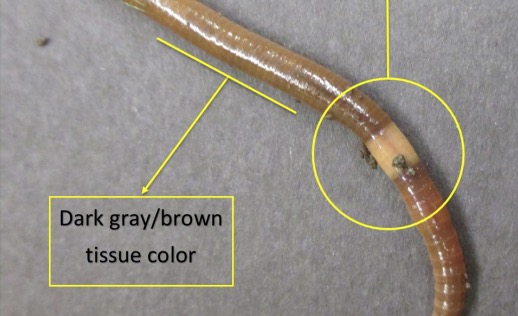ST. LOUIS, Mo. (KTVI) — An invasive species of worm is wriggling its way into the Midwest.
“Jumping Worms” (Amynthas spp) thrash wildly when handled, are 4 to 8 inches long, move quickly like a snake, and can shed their tails when threatened.

The Jumping Worms originally come from Asia and were officially found in the Midwest by the University of Wisconsin at Madison in 2013. Researchers have been tracking their movements since then. They may have been brought to the United States as fish bait.
The worms can be found in the top few inches of soil, leaves, or mulch. They are displacing earthworms, centipedes, and other animals. They also damage plant roots, deplete nutrients, and alter the water-holding capacity of the soil. Plants become more susceptible to pests, drought, and disease. The worms are a danger to agriculture, gardens, and forests.
The jumping worms were more common on the East and West Coasts of the United States. Now the worms have been spotted in Midwestern states like Missouri, Illinois, Iowa, Kansas, Nebraska, Oklahoma, Texas, Louisiana, Indiana, Minnesota, Indiana, Ohio, Kentucky, and Tennessee.
They are in the Metro-East. The worms are confirmed in Madison County and suspected in St. Clair County. Some are in Missouri’s urban areas.
The University of Illinois says that the worms can’t survive past frigid winters of the upper Midwest. But, they have egg casings that will persist through the cold weather.
The Missouri Department of Conservation is asking anyone to kill any jumping worms that they find.
University of Illinois Horticulture Educator Nicole Flowers-Kimmerle has outlined these steps to help stop the spread of the worms:
- Thoroughly clean tools, shoes, and vehicles when moving from one site to another.
- Only purchase compost, mulch, or other organic matter that has been heated to appropriate temperatures and duration to reduce the spread of pathogens, insects, and weeds. Jumping worm egg casings do not survive temperatures over 104°F
- Remove adult jumping worms. Place adults in a plastic bag and leave in the sun at least 10 minutes. Dispose of the bag in the trash.
- Remove soil from all plants before transporting them
- Wash roots by completely submerging plant roots in water and washing away remaining soil. Water is enough to remove soil and other materials from the roots.
- Buy bare-root plants when possible.
- Do Not buy jumping worms for bait, vermicomposting, or gardens.
- Follow Plant Sharing Best Practices

